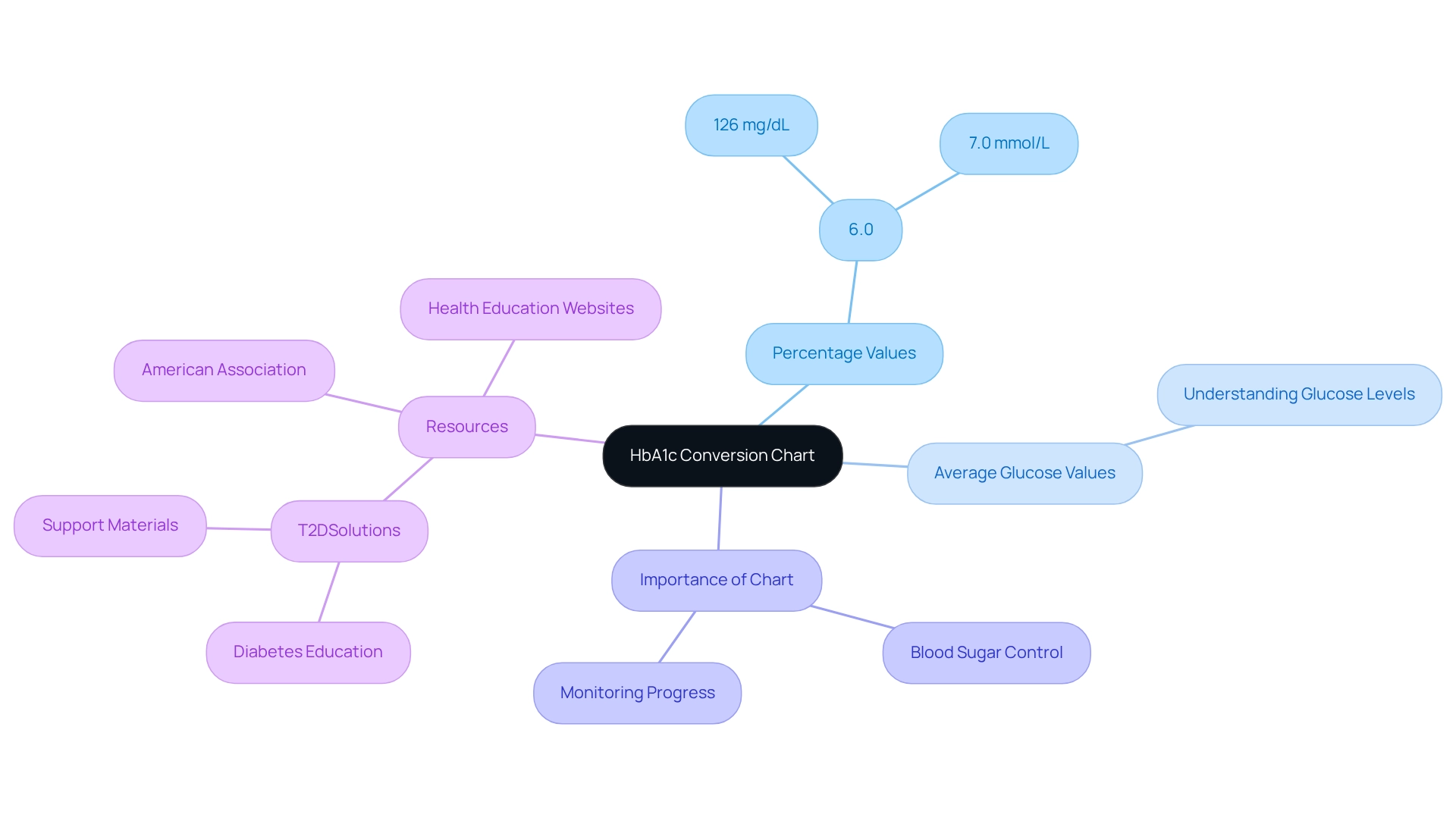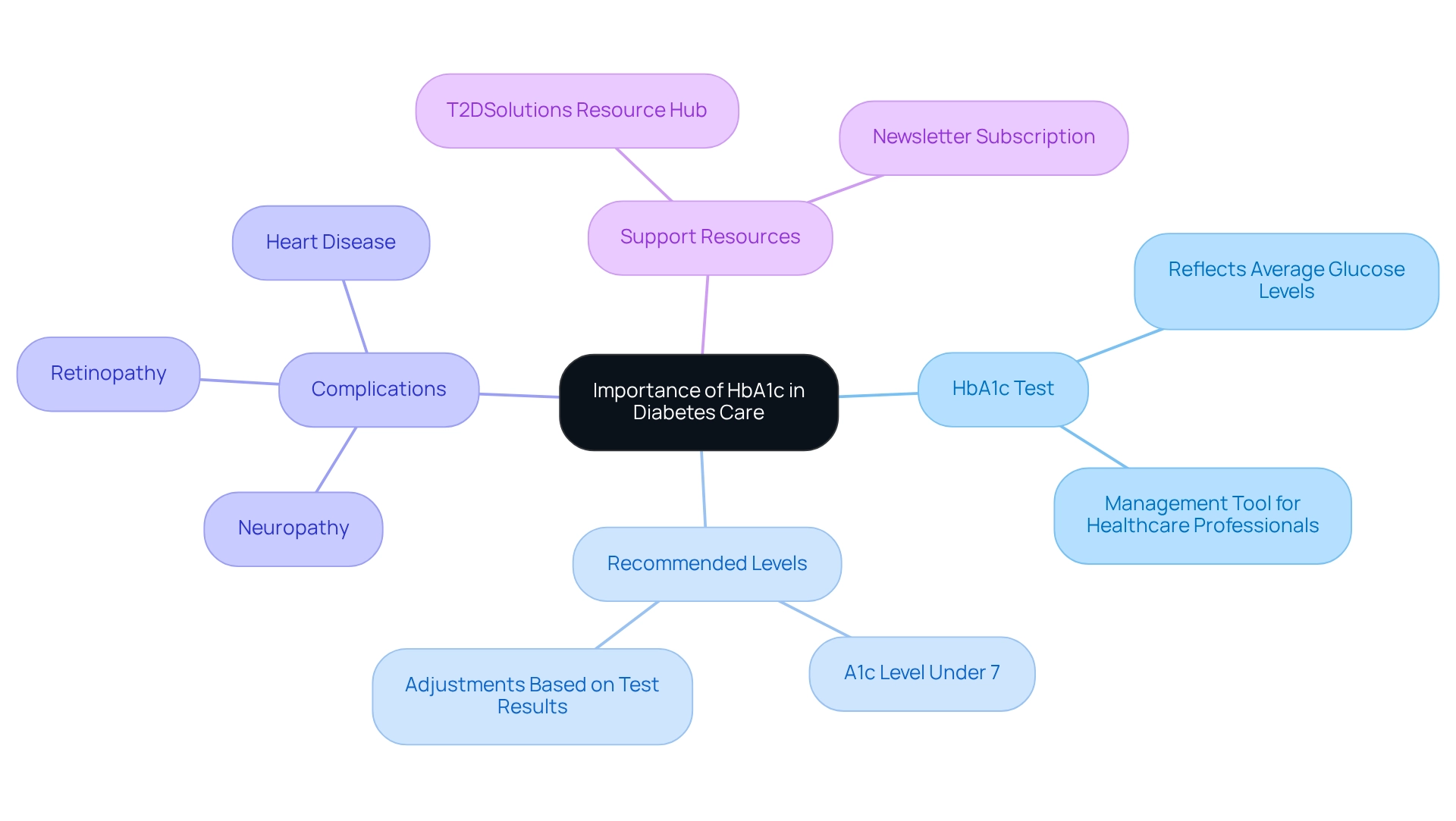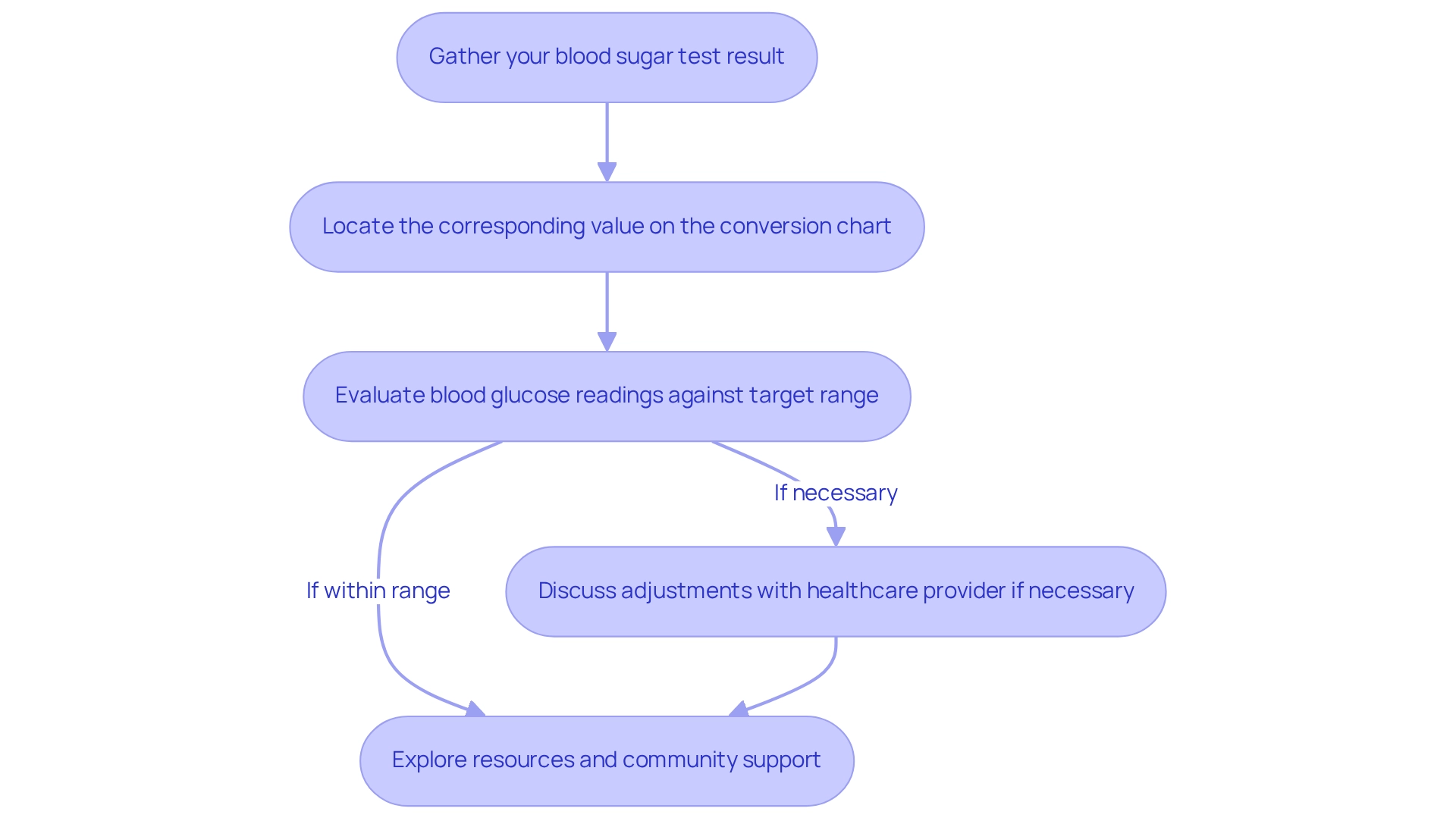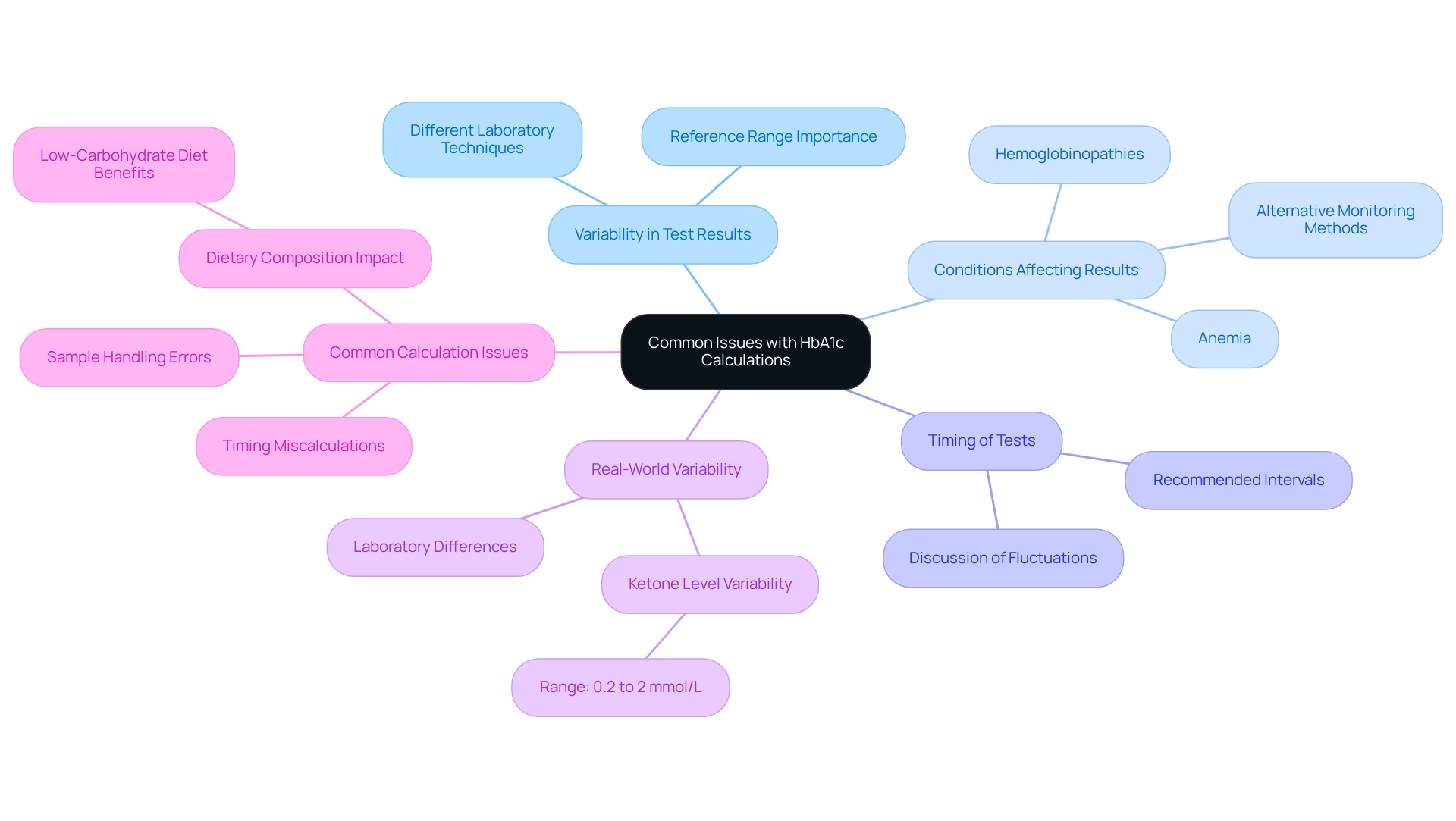Overview
This article highlights the vital role of mastering HbA1c conversion in managing diabetes effectively. It provides essential tools and knowledge to help you interpret blood sugar levels accurately, which is crucial for your health. Understanding the conversion chart can feel overwhelming, but it’s important to know that maintaining an HbA1c level under 7% can significantly lower your risk of diabetes-related complications. This level reflects your average glucose control over the past two to three months, and achieving it is a meaningful step toward better health.
You're not alone in this journey. It's understandable to feel a bit lost when navigating these numbers, but with the right information and support, you can take control of your diabetes management. Remember, reaching out for help is a sign of strength, and there are resources available to guide you through this process. Together, we can work towards a healthier future.
Introduction
Navigating the complexities of diabetes management can feel overwhelming, especially when trying to grasp the importance of HbA1c levels. This essential metric not only reflects your average blood glucose levels over the past two to three months but also plays a vital role in shaping your treatment plan and reducing the risk of complications. With the aid of HbA1c conversion charts, you can translate your results into actionable insights, helping you stay within your target ranges.
However, it's important to recognize that various factors can complicate these calculations, from laboratory discrepancies to underlying health conditions. Understanding these nuances of HbA1c monitoring can empower you to take proactive steps toward effective diabetes management. Remember, you're not alone in this journey; we are here to support you every step of the way.
Understand the HbA1c Conversion Chart
Comprehend the HBA1C conversion chart, as understanding this conversion chart is essential for translating percentages into average blood glucose values, expressed in mg/dL or mmol/mol. For instance, a hemoglobin A1c level of 6.0% corresponds to an average blood glucose concentration of about 126 mg/dL (7.0 mmol/L).
It's important to familiarize yourself with this chart, as it reflects how your HbA1c results indicate your blood sugar control over the past two to three months, including the hba1c conversion charts available from reliable sources such as the American Association or health education websites.
Additionally, T2DSolutions serves as a valuable resource center for diabetes-related education, offering further materials and support for newly diagnosed patients. Keeping a copy of the conversion chart handy can be beneficial for reference during your healthcare appointments or while monitoring your progress at home.
Consider subscribing to T2DSolutions for updates on new resources and information related to blood sugar management. Remember, you're not alone in this journey—support is available to help you navigate your path to better health.

Recognize the Importance of HbA1c in Diabetes Care
The glycosylated hemoglobin test is a vital tool in managing blood sugar levels, as it is crucial for HBA1C conversion, reflecting average glucose concentrations over the past two to three months. This test helps healthcare professionals assess how well your condition is being managed and whether any treatment strategies need adjustment.
For those facing blood sugar challenges, maintaining an A1c level under 7% through HBA1C conversion is generally recommended to lower the risk of complications such as:
- Neuropathy
- Retinopathy
- Heart disease
Regularly checking blood sugar levels allows for timely actions and adjustments in lifestyle or medication, making it a core aspect of effectively managing your condition.
As T2DSolutions launches as a comprehensive resource hub for Type 2 and Type 3 diabetes education, it aims to provide essential support and information to newly diagnosed patients. Understanding the significance of blood sugar levels and how to manage your condition effectively is crucial, and we are here to guide you through this journey.
To stay informed about our resources and receive helpful information, we warmly invite you to subscribe to our newsletter. Remember, you're not alone in this journey; we are here to support you every step of the way.

Utilize the HbA1c Conversion Chart for Calculations
To effectively use the HbA1c conversion chart, let's take a moment to walk through these steps together:
-
First, gather your most recent blood sugar test result from your healthcare provider. This is an important starting point in understanding your health.
-
Next, locate the corresponding value on the conversion chart. For example, if your blood test result is 7.0%, find this figure on the chart. You'll see that it corresponds to an average blood glucose concentration of roughly 154 mg/dL (8.6 mmol/L). This connection is crucial for your understanding.
-
With this information in hand, take a moment to evaluate whether your blood glucose readings fall within the target range established by your healthcare provider. It's understandable to feel uncertain about this, but remember, you have the tools to navigate it.
-
If your HbA1c conversion is higher than the suggested standard, consider discussing possible adjustments to your care strategy with your healthcare team. Open communication is key, and they are there to support you.
Additionally, T2DSolutions is here to support you in your diabetes management journey. We invite you to explore our resources for more information on maintaining healthy blood glucose levels. Connecting with a community that understands your challenges can make all the difference. Remember, you're not alone in this journey—we are here to support you every step of the way.

Troubleshoot Common Issues with HbA1c Calculations
When calculating or interpreting HbA1c results, it's common to encounter several issues that may cause concern:
-
Variability in Test Results: Different laboratories often employ various techniques for blood sugar testing, which can lead to inconsistencies. It’s essential to refer to the specific reference range provided by your testing lab to understand your results accurately.
-
Conditions Affecting Results: Certain medical conditions, such as anemia or hemoglobinopathies, can distort glycated hemoglobin results. If you have any of these conditions, please inform your healthcare provider. They may suggest alternative monitoring methods to ensure accurate assessments.
-
Timing of Tests: Regular monitoring is crucial for effective diabetes management. Ensure that your blood sugar test is conducted at the recommended intervals, typically every three to six months. If you notice significant fluctuations in your blood glucose readings, it’s important to discuss the timing of your tests with your provider for precise monitoring.
-
Real-World Variability: Recent findings indicate that test results for glycated hemoglobin can differ greatly among various laboratories, complicating blood sugar control. Understanding this variability is essential for correctly interpreting the results of your HbA1c conversion. For example, ketone levels can change throughout the day, ranging from 0.2 to 2 mmol/L, which may indicate variations in your overall diabetes care.
-
Common Calculation Issues: Miscalculations can occur due to various factors, including incorrect sample handling or timing. Being aware of these common pitfalls can help you and your healthcare provider troubleshoot any discrepancies effectively. A recent case study titled "Emerging Evidence Against Traditional High-Carbohydrate Guidelines" highlights how dietary modifications, such as removing starchy or high-sugar carbohydrates, can enhance blood sugar levels. This underscores the importance of considering dietary composition in your approach.
By addressing these concerns in advance, you can improve the accuracy of your blood sugar monitoring and enhance the HbA1c conversion in your overall health strategy. As C Gardemann observed, "Written consent has been secured from the patient after a complete explanation of the purpose and nature of all procedures utilized," which emphasizes the importance of clear communication with your healthcare provider regarding your HbA1c conversion results and treatment approaches.
At T2DSolutions, we are committed to providing extensive resources and community support for individuals dealing with Type 2 and Type 3 conditions. By integrating educational materials and support initiatives, we aim to empower you on your diabetes management journey. Remember, you're not alone in this journey—we are here to support you every step of the way.

Conclusion
Understanding and managing HbA1c levels is crucial for anyone navigating the complexities of diabetes. The HbA1c conversion chart acts as a vital resource, transforming intricate data into clear metrics of average blood glucose levels. It's important to recognize that maintaining an HbA1c level below 7% can significantly lower the risk of complications, empowering you to take charge of your health journey.
However, it's essential to remain aware of potential pitfalls in HbA1c calculations. Variability in test results, medical conditions affecting outcomes, and the timing of tests can all influence how effectively diabetes is managed. By staying vigilant and proactive in addressing these common challenges, you can gain a more accurate understanding of your health status and make informed decisions about your treatment plans.
The journey of diabetes management is ongoing, but with the right resources and knowledge, it becomes much more navigable. Utilizing tools like the HbA1c conversion chart, staying informed about potential complications, and maintaining open communication with your healthcare providers are key components of effective diabetes care. Supportive communities, such as T2DSolutions, offer valuable resources that can further enhance your journey, ensuring that you are not alone as you strive for better health and well-being.
Frequently Asked Questions
What is the purpose of the HbA1c conversion chart?
The HbA1c conversion chart is essential for translating percentages of hemoglobin A1c into average blood glucose values, expressed in mg/dL or mmol/mol.
How does a hemoglobin A1c level of 6.0% relate to average blood glucose?
A hemoglobin A1c level of 6.0% corresponds to an average blood glucose concentration of about 126 mg/dL (7.0 mmol/L).
Why is it important to understand the HbA1c conversion chart?
Understanding the HbA1c conversion chart is important as it reflects how your HbA1c results indicate your blood sugar control over the past two to three months.
Where can I find reliable HbA1c conversion charts?
Reliable HbA1c conversion charts can be found from sources such as the American Association or health education websites.
What resources does T2DSolutions offer for diabetes education?
T2DSolutions serves as a valuable resource center for diabetes-related education, offering materials and support for newly diagnosed patients.
How can I use the HbA1c conversion chart in my healthcare routine?
Keeping a copy of the conversion chart handy can be beneficial for reference during healthcare appointments or while monitoring your progress at home.
Should I subscribe to T2DSolutions for updates?
Yes, subscribing to T2DSolutions can provide updates on new resources and information related to blood sugar management.
Is support available for individuals managing diabetes?
Yes, support is available to help individuals navigate their journey to better health in managing diabetes.
